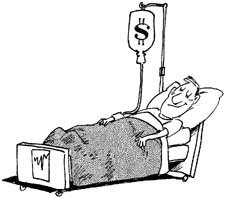
Your Mindset and Your Scale
One of Treitler's aha moments came after the study subjects took a 120-item multiple-choice questionnaire that assesses thinking styles, called the Herrmann Brain Dominance Instrument (HBDI). Simply put, the theory behind it goes like this: We all naturally tend to process information, solve problems, and relate to others in a particular way, and such inclinations roughly correspond to four different quadrants of the brain—two on the right, two on the left. These preferences are like mental defaults your brain automatically resorts to when evaluating the world unless otherwise prompted, and most people employ some combination of quadrants.
"A" quadrant (upper left): People who favor this area are analytical, mathematical, logical problem solvers. Drawn to statistics and the workings of machinery, they can over analyze a situation so much, they have trouble taking action.
"B" quadrant (lower left): These people are controlled, methodical, disciplined, sticklers for structure and routine. Punctual and neat, they always have a plan, timetable, and calendar with appointments penciled in.
"C" quadrant (lower right): Lower-right thinkers are emotional, spiritual, and focused on people and human connection.
"D" quadrant (upper right): "D" types are strongly visual and easily bored, attracted to new ideas, fun, and risk taking.
And the Successful Dieters?
"We found that those with the most dramatic losses scored noticeably higher in favoring 'B,' the lower left," says Treitler. This makes sense to her, having observed many people struggling with weight. Someone inclined toward plans and routines, who sees life through methodical eyes, would be the most comfortable with the mundane details of calorie counting and portion control; she would also be more able to coolly observe herself and catalog obstacles and failings—without succumbing to an emotion like self-hatred.
A Leap of Imagination
Breakthrough number two occurred during another study with the NWCR volunteers. When Treitler listened to subjects' stories, something stood out: They'd all gone through an inner transformation almost like those celebrated in traditional rites of passage. Each had found a coach, mentor, or guide for the journey, had pulled back and separated somewhat from his or her old environment, and then was "reborn" into a different way of life. At this point, the newly thin person became a leader rather than a follower, a change that opened the door to further goals and achievements, often in fields completely unrelated to weight loss. (One subject, for example, asked a chef at the university where he worked to develop an aggressive diet for him, dropped nearly half his body weight, then took a leave from his job to help start a law school in Africa, where he reemerged as a passionate long-distance walker and bird-watcher.)
"All the subjects had incorporated some meditative element into their lives," Treitler says. "It might have been walking or yoga, but it was self time, a white space where they could disengage from the old, obsessive behavior." This transformation of identity appears crucial in keeping weight off. Without a new self who's clearly different from the old, overweight one, it's too easy to revert to former unhealthy habits.
Can you reprogram your brain?






No comments:
Post a Comment